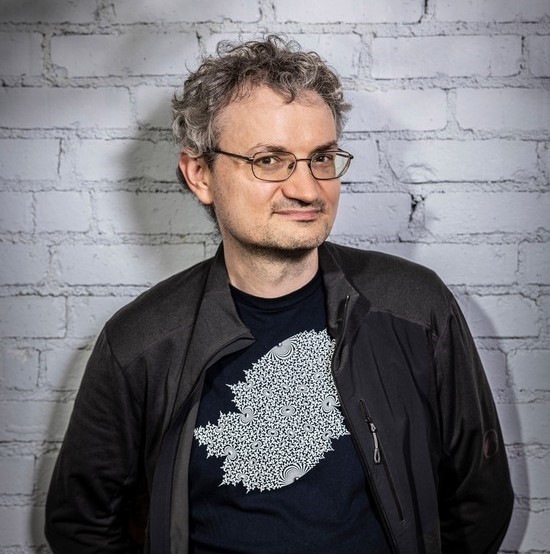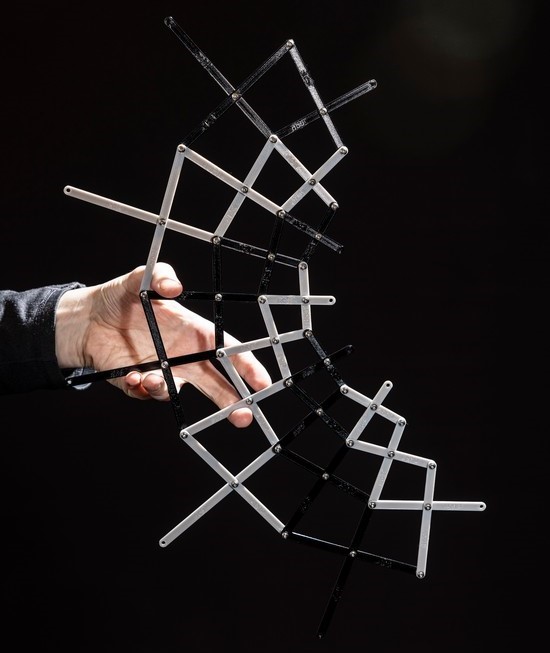Another orbit around the sun and here we are again: back where we started but
spun about — changed, perhaps deranged.
Henry
Segerman, a British American mathematician and mathematical artist at Oklahoma
State University, has invented just the puzzle for this disorienting annual
event: Continental Drift, a 3D sliding puzzle that made its debut earlier this
year. The underlying geometric concept is holonomy: When you travel a loop on a
curved surface and return to the starting point, you arrive somewhat turned
around, rotated, perhaps by 180 degrees.
اضافة اعلان
“Take a
mathematical idea, can you make it real?” — this question, Segerman said, is
what motivates his inventions.
He is
keen on visualizing mathematics, whether with 3D printing (he has written a
book on the subject) or through non-Euclidean virtual reality experiences. But
Segerman has aphantasia, an inability to construct mental pictures, or
“visually hallucinate images at will,” as he puts it. This might explain his
passion for making concrete pictures, especially the impressive collection he
produced in 2022.
Continental
Drift is Earth in miniature, mapped onto a truncated icosahedron — a soccer
ball — with its regular patchwork of 12 pentagonal faces and 20 hexagonal
faces.
The
conceptual inspiration was a Victorian craze: the classic 15 Puzzle, wherein
square tiles numbered 1 to 15 are scrambled on a four-by-four grid, with one
square left empty; you solve the puzzle by sliding tiles around into numerical
order.
In
Continental Drift, a spherical version of the 15 Puzzle, it is the hexagonal
tiles that are scrambled. (The pentagons are recessed and remain stationary).
“One of the hexagons, this one in the South Pacific, comes out,” Segerman
explains on his YouTube channel. “We can then activate the San Andreas fault
and slide California south into the ocean. And we can keep going, mixing up all
of the continents.”
Holonomy
happens when a tile travels a full loop along the curved surface of the puzzle:
Slide the tile featuring, say, Greenland all the way around the perimeter of a
single pentagonal tile — perhaps the tile featuring the North Atlantic. After a
complete loop, the Greenlanders return to their starting position rotated by 60
degrees. If the loop encompasses two adjacent pentagons, then the tile returns
to the starting point rotated 120 degrees. And so on.
Maker
mathSegerman’s
more formal investigations are in topology, the study of geometric objects
without regard for lengths or angles. “All you have left is how things are
connected together — how many holes a thing has, and so on,” he said. As an old
topology joke goes: “A topologist is somebody who can’t tell the difference
between a coffee mug and a doughnut.”
 Henry Segerman, a British American mathematician and
inventor at Oklahoma State University.
Henry Segerman, a British American mathematician and
inventor at Oklahoma State University.
“Henry
is a mathematician who also likes making,” said his younger brother and
sometime collaborator, Will Segerman. Will Segerman, who lives in Manchester,
England, is a maker who likes mathematical shapes; he studied fine art and now
designs and manufactures escape-room puzzles. Together, the brothers’ creative
process is to ask of everything, “But what if…?” Whenever Henry Segerman
mentions a new project, it is invariably “very, very clever,” said Will
Segerman, who nonetheless looks to poke holes.
A few
years ago, Henry Segerman demonstrated Extensors: a construction kit for making
extending mechanisms from scissor-like hinged parts. “Not stupid enough,” said
his brother, who wanted more silliness. They added an activator handle on one
end and a four-pronged claw on the other. The result, which made its debut in
April, was the Grabber Mechanism — the patent is pending.
Sabetta
Matsumoto, an applied mathematician at the Georgia Institute of Technology and
Segerman’s partner, gave input into the contraption’s development and came up
with the name Extensor. Between them, math is “a pretty common conversation,”
Matsumoto said.
Idea
colliderIn a
variation on the scissor theme, Segerman and Kyle Van Deventer, a former student,
presented Kinetic Cyclic Scissors this summer.
This
invention was the answer to a problem: Given a tile pattern of “self-similar”
quadrilaterals — the same shape but rotated, translated, scaled — can the tiles
be replaced with scissor linkages (like a scissor lift), and can the structure
then be made to move?
 Henry Segerman, a British American mathematician and
inventor at Oklahoma State University, with his Continental Drift puzzle.
Henry Segerman, a British American mathematician and
inventor at Oklahoma State University, with his Continental Drift puzzle.
Two
classes of shapes work, they proved: “boring parallelograms” and “surprising
cyclic quadrilaterals,” cyclic meaning that all vertexes of a quadrilateral lie
on a circle. Van Deventer, now an aerospace engineer at Aurora Flight Sciences
in Manassas, Virginia, sees potential applications in the aerospace industry;
for proprietary reasons, he declined to elaborate. Scissor systems have been
used in architecture, space technologies and satellite panels. In a YouTube
comment, a viewer suggested that this mechanism would serve as “one hell of a
back-scratcher.”
Also
consider the Countdown d24, a 24-sided die that is the latest invention to
emerge from the Dice Lab, a business partnership with Robert Fathauer, a
mathematical artist and puzzle designer in Apache Junction, Arizona. The
Countdown d24 is used to keep track of points, such as in the card game Magic:
The Gathering.
One
problem with some countdown dice, which often are the shape of an icosahedron
with 20 triangular sides, is that the numerical path around the shape doesn’t
follow a consistent pattern, which leaves you fumbling around to find the
number you want.
The
Countdown d24 overcomes this problem by instead being a sphericon, fashioned from
a triple-cone shape, like an awkwardly shaped football, which is then cut up,
twisted about and glued back together.
This
invention resulted from a “collision of ideas,” as do many of Segerman’s
creations. He had previously collaborated on making a rolling circus acrobatics
apparatus based on a two-cone sphericon.
For the
countdown die, two cones did not solve that fumbling problem, but three cones
did. The result displays a clear path, zigzagging up and down around the die,
counting down from 24 to one, making it a cinch to rotate the die to the number
you want.
And as
it turned out, the die can “roll along its path,” Segerman noted. Given the
right slope, gravity, and a nudge, the die wiggles along a perfect
chronological countdown. “That was a surprise,” Segerman said. “Reality does
tend to bite back.”
Fight
or flightContinental
Drift is not Segerman’s first time around the holonomy block. Last year, he
made the dodecahedral holonomy maze and more recently the Helix Cube Puzzle.
His holonomy craze started with riffs on the 15 Puzzle that predated
Continental Drift. He added hinges so the tiles can rotate as they slide,
producing the 15+4 Puzzle and then the Hyperbolic 29 Puzzle.
 Henry Segerman, a British American mathematician
and inventor at Oklahoma State University, demonstrates his Kinetic Cyclic
Scissors grid.
Henry Segerman, a British American mathematician
and inventor at Oklahoma State University, demonstrates his Kinetic Cyclic
Scissors grid.
“Just
looking at this puzzle activates my fight-or-flight response,” a YouTube
commenter wrote of the Hyperbolic 29 Puzzle. Segerman’s friend Rick Rubenstein,
a former professional juggler and a semiretired software engineer in Sunnyvale,
California, followed with: “Henry Segerman, Mad Genius.”
Rubenstein
got to know Segerman as a fellow recreational juggler at Stanford University.
Segerman can stably juggle five balls, and he often takes 100-catch work
breaks.
“He’s
actually a very sensible guy with a slightly non-Euclidean sense of humor,”
Rubenstein said.
Indeed,
while Segerman knows that his puzzles are solvable, he does not trouble himself
with the task of finding the solutions.
Nonetheless,
for a rough measure of Continental Drift’s complexity, he calculated that it
has 7 × 10³¹ states, or possible configurations. (The Rubik’s Cube, with
roughly as many moving parts, has only around 4 × 10¹⁹ states.) A YouTube
viewer calculated that exactly half of Continental Drift’s states are
attainable.
To
Segerman’s knowledge, only one person has solved Continental Drift so far. “I
solve it by unscrewing the removable part of the frame that lets you take the
tiles out,” he said. Then he reorients himself and the tiles and screws the
puzzle back together.
Read more Gaming
Jordan News



